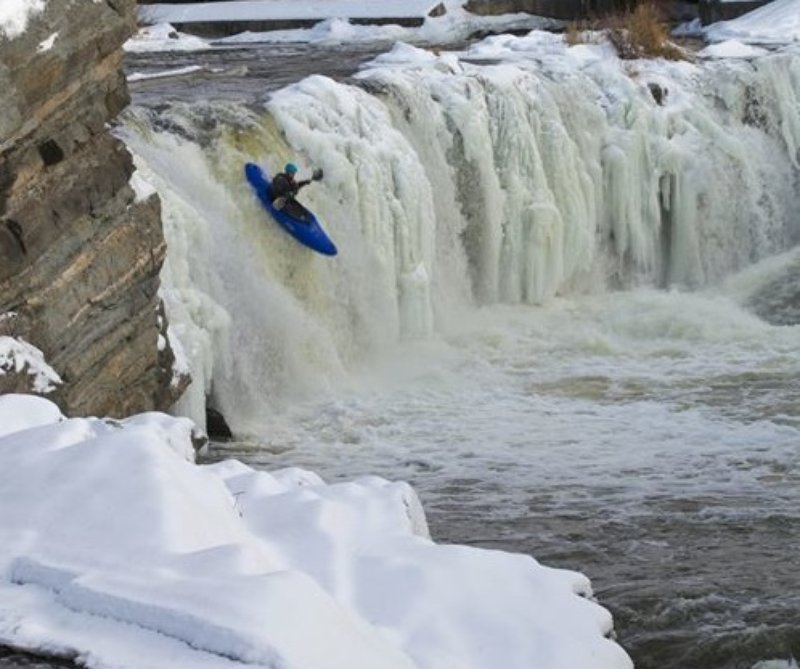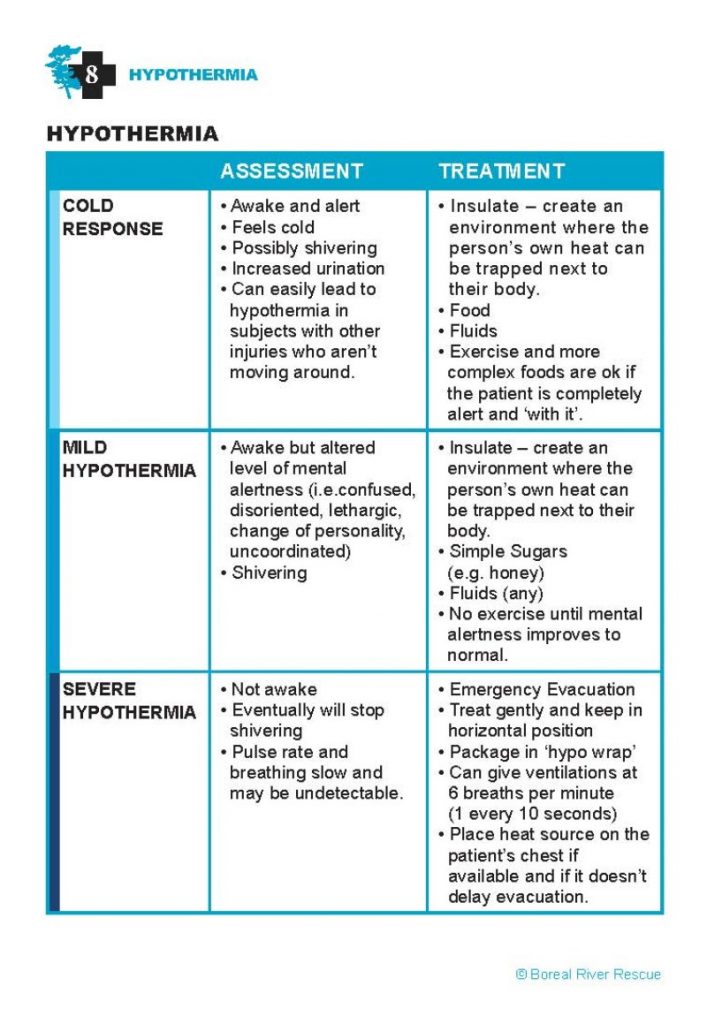Cold Water Paddling – Know the Risks and Stay Safe
By Jamie Orfald-Clarke, Boreal River Rescue instructor
In most of Canada, even the most adventurous paddlers put away their boats for part of the year. But with the right gear, and an understanding of the added risks presented by cold weather paddling, you can safely stay on the water from early spring to late fall, and spend less time inside wishing you were paddling.

Dressing for paddling in the cold
Being appropriately dressed for the conditions is essential. These guidelines will help you stay warm:
- Dress for the water temperature, not the weather.
- No cotton. It makes you colder when it is wet. Synthetics or wool are good options since they still provide insulation when wet.
- Dress in layers for versatility. Carry a small drybag with an extra layer, or in case you need to remove one. Start with a thin base layer, which should have a tight weave, and a snug fit.
- Protect yourself from from the wind. See outer layers below.
- Your PFD provides important insulation. Keep it on during breaks on shore to stay warmer.
- Wear a skull cap or toque: your head is an area of rapid heat transfer. Neoprene mitts or pogies (mitts which attach to a paddle), and neoprene socks protect your hands and feet.
The outer layer, just below your PFD, is especially important, providing protection from the cooling power of wind and water. There are a few different options:
Drysuits are made with a waterproof breathable fabric, and latex gaskets, and are designed to keep all water out. The suit itself does not provide much insulation, but layers can be added below.
Pros:
- Warmest and most comfortable option when working properly
- Exact fit not necessary. Allows flexibility of layering systems.
- Provide a protective barrier if used for rescues in contaminated water
Cons:
- Expensive
- Delicate, not effective when damaged
Wetsuits are made of neoprene. They let water in and trap it inside the suit, allowing the body to warm the water. A tight fit is important so this layer of water stays against the skin, and does not get replaced by more cold water. There are several options for coverage, from short legs and no arms to full body and even a hood. Several thicknesses are available, but thicker than 3 mm makes it hard to fold yourself into a canoe or kayak.
Pros:
- Durable and long lasting. Effectiveness is not compromised by small holes. Provides protection from bumps and scrapes
- Less expensive
- Provides some additional flotation
Cons:
- Not as warm or comfortable, especially on long days
- Sleeveless “Farmer John” or “shorty” wetsuits do not provide much upper body wind protection.
Drytops are made of the same material as drysuits, but only cover from the waist up. When used in combination with a kayak skirt, they can be completely waterproof, but in the event of a swim, they will leak at the waist. Splash Jackets are similar, but with neoprene wrist and neck gaskets; they are effective for wind and waves, but do not stop water from entering in the event of a swim.
Drypants are the bottom half of a drysuit, and have neoprene ankle gaskets or sewn in booties. Caution should be used with drypants, since they can fill up with water, and make swimming or exiting the water difficult. Practice swimming in flatwater first, and climbing onto shore or into a boat from deep water.
Splash Pants have neoprene gaskets instead, and allow water to pass through more freely.
Combinations of these options are also possible. A drytop and drypants combination is not as dry as a full suit, but some paddlers find it to be effective. Again, test drypants before using them in moving water. It is also possible to combine a wetsuit with a splash jacket or drytop to provide wind protection.
Hypothermia prevention and preatment
Hypothermia occurs when the core body temperature drops. This is caused by a combination of heat loss and an inability of the body to replace the lost heat. So while choosing the right clothing is important, it isn’t the only thing to consider.
Food and water
Eat and stay hydrated before and during the paddling day to keep your body’s furnace going. Anticipate the body’s need for additional calories due to exercise and increased heat loss. Bring some emergency food (simple sugars) which can be quickly accessed in case someone ends up with mild hypothermia.
Access to warm environment
If someone becomes hypothermic, an extra layer in a drybag probably won’t cut it. In the coldest conditions, it is best to paddle close to a vehicle or heated building, instead of choosing an extended wilderness run. When choosing to paddle further from heated areas it is a good idea to carry one or more sleeping bags, a tarp, and maybe a tent. Carry fire starter in a waterproof case in a PFD pocket so it is always easy to access.
This chart outlines how to assess and treat hypothermia.

Know the hazards of paddling in cold water
In addition to the risks presented by cold water and weather, there are a few conditions which differ from summer paddling:
Ice safety
Moving water stays ice free much later than still water, and in some cases may remain ice free for the entire winter. This can mean that an ice free rapid might be followed by a thick sheet of ice covering the flatwater below. Ice can also build up along river edges, and may make some eddies inaccessible, or create undercuts. Rapids should be scouted thoroughly, even on well known runs.
Flooding and high water hazards
During spring breakup, there is often a period of flooding, or very high water. There are several high water hazards that you may encounter:
- Watch for floating chunks of ice, logs, or other debris. Consider upstream spotting, and stay clear.
- There may be new strainers due to erosion, or floating logs that have gotten pinned.
- At flood levels, water may be running through the trees, or channels which are normally dry. This results in a high likelihood of strainers or sieves.
- High water rapids are likely to be more continuous and challenging. Some may be significantly different than at low water.
Likelihood vs. consequence on the river
| Low Consequence | High Consequence | |
| Low Likelihood | GO | MAYBE |
| High Likelihood | MAYBE | DON’T GO |
At any time of the year, staying safe on the river means assessing the likelihood of something going wrong, and the potential consequences if it does. It isn’t always easy to decide, as the table shows.
For newer paddlers most choices may seem to fit into the MAYBE categories. As you gain experience, many situations will begin to fit more neatly into the GO or DON’T GO boxes. If you choose a rapid that you are comfortable swimming, dress for the water temperature, and act to prevent hypothermia, you don’t have to worry about the likelihood of missing your line.
Learn to identify hazards which lead to unacceptable consequences, and you will know when to walk around (and when it’s time to put away your boat and get out your skis!).
Take this knowledge with you in your PFD pocket. Order a Whitewater Rescue Field Guide.

